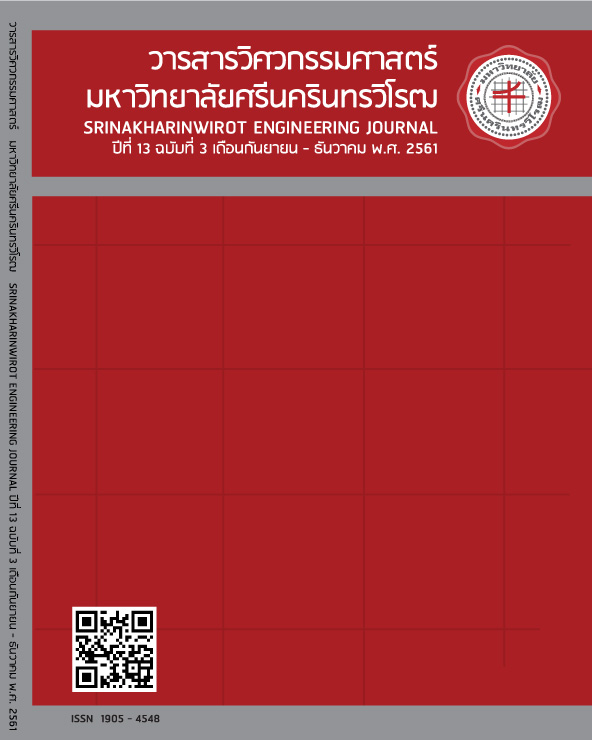Nitrate Removal Using Photocatalytic Reduction Process with Ag-TiO2 Catalyst
Main Article Content
Abstract
This research aims to study the efficiency of nitrate (NO3- -N) removal by photocatalytic reduction process using Ag doped TiO2 (Ag-TiO2) nanopowder catalyst. The Ag-TiO2 was prepared by composite colloid deposition under low temperature with acid condition. Ag was doped into TiO2 film by 3 different amounts, i.e. 0.1%, 0.5% and 1.0% weight to volume. The physical characteristics of the catalyst prepared were investigated by X-ray fluorescence spectrometer (XRF) and Brunauer, Emmett and Teller analyser (BET) that can identified elements and specific surface area of the catalyst prepared. The results showed that all of Ag-TiO2 nanopowder catalyst has the required components. The efficiency of photocatalytic reduction process of nitrate removal was evaluated from nitrate removal with initial nitrate concentration of 100 mg.L-1 as N under UVA light source of 1,000 mW.cm-2. The highest efficiency of photocatalytic reduction process for nitrate removal was 97.55% within 180 min and the highest reaction rate for NO3- 1.08 mg.L-1 as N. In addition, the selectivity (S) of nitrogen conversion in photocatalytic reduction process 90 min were 7.17%, 2.30% and 90.53%, for nitrite , ammonia and nitrogen respectively
Article Details
Copyright belongs to Srinakharinwirot University Engineering Journal
References
[2] H. O. Tugaoen, S. Gercia-Segura, K. Hristovski, and P. Westerhoff, “Challenges in photocatalytic reduction of nitrate as a water treatment technology,” Science of the Total Environment, vol. 599-600, pp. 1524-1551, May 2017.
[3] D. Bamba, M. Coulibaly, and D. Robert, “Nitrogen-containing organic compounds: origins, toxicity and conditions of their photocatalytic mineralization over TiO2,” Science of the Total Environment, vol. 580, pp. 1489-1504, December 2016.
[4] M. Hou, Y. Tang, J. Xu, Y. Pu, A. Lin, L. Zhang, J. Xiong, J. Yang, and P. Wan, “Nitrate reduction in water by aluminum-iron alloy particles catalyzed by copper,” Journal of Environmental Chemical Engineering, vol. 3, pp. 2401-2407, August 2015.
[5] P. Thongchai, “Biological removal of nitrogen and phosphorus,” Environmental Engineering Assocation of Thailand, Bangkok, 2001, pp. 50-120.
[6] K. Doudrick, T. Yang, K. Hristovski, and P. Westerhoff, “Photocatalytic nitrate reduction in water: managing the hole scavenger and reaction by-product selectivity,” Applied Catalysis B: Environmental, vol. 136-137, pp. 40-47, February 2013.
[7] K. Kobwittaya, and S. Sirivithayapakorn, “Photocatalytic reduction of nitrate over TiO2 and Ag-modified TiO2,” Journal of Saudi Chemical Society, vol. 18, pp. 291-298, February 2014.
[8] S. Nasseri, M. Fazlzadehdavilb, A. Mahvi, and M. Gholami, “Application of Ag-doped TiO2 nanoparticle prepared by photodeposition method for nitrate photocatalytic removal from aqueous,” Desalination and Water Treatment, vol. 37-39, pp. 7137-7144, November 2013.
[9] B. Naik, C. H. Manoratne, A. Chandrashekhar, A. Iyer, V. H. Prasad, and N. N. Ghosh, “Preparation of TiO2, Ag-TiO2 nanoparticle and TiO2-SBA-15 nanocomposites using simple aqueous solution-based chemical method and study of their photocatalytical activity,” Journal of Experimental Nanoscience, Vol. 8, pp. 462-479, April 2013.
[10] J. V. Hernández, S. Coste, A. G. Murillo, F. C, Romo, and A. Kassiba, “Effect of metal doping (Cu, Ag, Eu) on the electronic and optical behavior of nanostructured TiO2,” Journal of Alloys and Compounds, vol. 710, pp. 355-363, March 2017.
[11] J. Nadolna, D. Arenas-Esteban, M. Gazda, and A. Zaleska-Medynska, “Pr-doped TiO2.The effect of metal content on photocatalytic activity,” Physicochemical Problems of Mineral Processing, vol. 50, pp. 515-525, January 2014.
[12] Notification of the ministry of public health No. 61. (1981). Drinking water in sealed container. 24 September 1981.
[13] A. V. Lozovskii, I. V. Stolyarava, R. V. Prikhod’ko, and V. V. Goncharuk, “Research of photocatalytic activity of the Ag/TiO2 catalysts in the reduction reaction of nitrate-ions in aqueous media,” Physical Chemical of Water Treatment process, Vol. 31, pp. 360-366, May 2009.
[14] Y. A. Shaban, A. A. El Maradny, and R. K. Al Farawati, “Photocatalytic reduction of nitrate in seawater using C/TiO2 nanoparticles,” Journal of Photochemistry and Photobiology A: Chemistry, vol. 328, pp. 114-121, May 2016.
[15] D. B. Luiz, S. Floriani Andersen, C. Berger, and H. J. José. “Photocatalytic reduction of nitrate ions in water over metal-modified TiO2,” Journal of Photochemistry and Photobiology A: Chemistry, vol. 246, pp. 36-44, August 2012.
[16] W. Gao, R. Jin, J. Chen, X. Guan, H. Zeng, F. Zhang, and N. Guan, “Titania-supported bimetallic catalysts for photocatalytic reduction of nitrate,” Catalysis Today, vol. 90, pp. 331-336, 2004
[17] O. Soares, M. Pereira, J. Órfão, L. Faria, and C. G. Silva, “Photocatalytic nitrate reduction over Pd-Cu/TiO2,” Chemical Engineering Journal, vol. 251, pp. 123-130, April 2014.
[18] E. Choi, K. Park, H. Lee, M. Cho, and S. Ahn, “Formic acid as an alternative reducting agent for the catalytic nitrate reduction in aqueous media,” Journal of Environmental Sciences, vol. 25, pp. 1696-1702, January 2013
[19] J. Sá, C. A. Agüera, S. Gross, and J. A. Anderson, “Photocatalytic nitrate reduction over metal modified TiO2,” Applied Catalysis B: Environmental, vol. 85, pp. 192-200, July 2009.
[20] H. T. Ren, S. Y Jia, J. J Zou, S. H. Wu, and X. Han, “A facile preparation of Ag2O/P25 photocatalyst for selectivity reduction of nitrate,” Applied Catalysis B: Environmental, vol. 176-177, pp. 53-61, March 2015.
[21] Notification of the national environmental board No. 27. Sea water quality standard. 2006.


